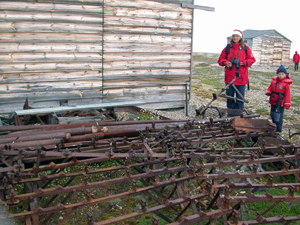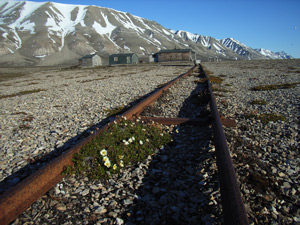Brucebyen
[78° 38.2' N 16° 44' E]
By Øystein Overrein (ed.), Jørn Henriksen, Bjørn Fossli Johansen, Kristin Prestvold
Directly across the fjord from Pyramiden is a small group of houses called Brucebyen. The houses were built in 1919 by the Scottish oceanographer and polar scientist William Spiers Bruce (1867-1921) and the company The Scottish Spitsbergen Syndicate Ltd. (SSS), as a base for the company’s coal explorations in the area. They hoped for coal deposits of commercial value.
Take care:
- Brucebyen is a protected cultural heritage site.
- In the bay east of Kapp Napier waters are shallow and this area is dry on low tide.
- Be aware of nesting grazing geese and birds on the ground.
- Do not tread on vulnerable moss at the edge of the ponds.
 Mining equipment and technical installations are collected and stored close to the houses. It is not always easy to make out the function of the equipment (but at the time it certainly filled a function). These are exiting and interesting cultural remains from a time when Brucebyen was a vivid place with great hopes for the future. (Image: Jørn Henriksen) Mining equipment and technical installations are collected and stored close to the houses. It is not always easy to make out the function of the equipment (but at the time it certainly filled a function). These are exiting and interesting cultural remains from a time when Brucebyen was a vivid place with great hopes for the future. (Image: Jørn Henriksen)
 After almost 100 years, the vegetation is about to take over the old railway tracks from The Scottish Spitsbergen Syndicate. (Image: Bjørn Fossli Johansen / The Norwegian Polar Institute) After almost 100 years, the vegetation is about to take over the old railway tracks from The Scottish Spitsbergen Syndicate. (Image: Bjørn Fossli Johansen / The Norwegian Polar Institute)
Brucebyen is beautifully situated in Billefjorden, close to the glacier of Nordenskiöldbreen and the impressive glacier front. The landscape along Billefjorden is considered one large cultural heritage site connected to The Scottish Spitsbergen Syndicate Ltd.’s activities in the area. The remains are two-folded; both scattered physical remains and also place names. The SSS has imprinted its history in the landscape.
The original name of the little group of houses was Camp Bruce after William Spiers Bruce. On his first arrival in Svalbard in 1898, he joined Prince Albert of Monaco on his vessel “Princesse Alice” as a scientist and a guest. He revisited Svalbard in 1899. On his third visit to Svalbard in 1906 he had financial support from the same prince to explore and map Prins Karls Forland. Throughout his life Bruce visited Svalbard nine times. The very last time was in 1920 when he lived in Brucebyen for a short period. By then he suffered from illness and he died shortly afterwards.
In 1909 Bruce established The Scottish Spitsbergen Syndicate Ltd., and prior to World War I the syndicate annexed large areas of Svalbard for mineral exploitation. There was no activity during the war. In 1919 SSS was re-organized and the activity was resumed, particularly in the area between Billefjorden and Tempelfjorden, but also on Prins Karls Forland and on the east coast of Spitsbergen.
Today this is the best preserved installation from SSS. Brucebyen consists of four relatively large houses; tree workers barracks and one outhouse concentrated in a small area, almost like a yard. The houses were pre-fabricated and brought in from Scotland and assembled ingeniously; each building and every part was numbered and named to ease the assemblage. On the interior walls names and numbers and other inscriptions related to SSS and the Scottish activity here are still visible. Today, one of the barracks is used as duty-cabin by the Governor of Svalbard. The largest building on the site (the so called Russ cabin ) burned down in 2010, but a copy was rebuilt in 2012 .
The area in and around Brucebyen has several traces of activities from the time this town was active. There are technical installations more than 90 years old that easily can be mistaken for rubbish, but in Svalbard these are automatically protected as cultural remains, enabling people today to relive the “Klondike-feeling” prevailing in Svalbard in the first decades of the 20th century.
Vulnerable elementsThe cultural remains are especially vulnerable, dispersed around the houses. The narrow gauge railway stretches across the tundra, be aware not to step on it. Landing sitesIt is possible to land several places close to Brucebyen. Look for the old railway and land nearby. Recommended trailsFollow the railway from the landing site to the group of houses. There are lots of nice flowers on the tundra and a bench with a table.
|